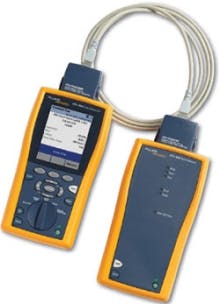From the January, 2012 Issue of Cabling Installation & Maintenance Magazine
Do not trust a patch cord that only passes channel testing; conduct your own test to verify performance.
Problem
As described in the article that begins on page 21 of this issue, the patch cords that complete a cabling channel can be of very high or very low quality, or anywhere in between. Low-quality cords can wreak havoc on a network.
Solution
You can purchase patch cords exclusively from manufacturers that 100-percent performance-test their products as one level of assurance. The only way to really know that a patch cord has been manufactured to standards is to test it to those standards. Recently Fluke Networks came out with patch cord test adapters for its DTX 1800 Cable Analyzer, allowing you the means to certify all commonly encountered patch cords in the field.
Procedure
1) Obtain a set of adapters for each category of patch cords you plan to test (Category 5e, 6, 6A). The adapters test the cords in accordance with TIA-568-C.2.
2) Keep the patch-cord test adapters on hand in order to spot-check patch cords that are tested in the factory, or to troubleshoot network problems that may be related to the patch cord.
3) When you are ready to use the adapters, plug one into each DTX unit—main and remote.
4) Set the test limit on the tester to the appropriate performance level (e.g. Cat 6A).
5) Note that if you are testing a Cat 6A cord, you will be testing to the ISO specification limits rather than the TIA specification limits. ISO specs are the stricter of the two.
6) Select the appropriate patch cord length (between 0.5 and 20 meters).
7) Press “enter.”
8) Plug the patch cord into the adapters on the main and remote units.
9) Test the cord.
Note also that you will have to replace the modular jack in the test head after performing approximately 750 tests, due to the insertion lifecycle of the RJ-45 jack. The replacement can be completed in the field.
These step-by-step procedures for conducting patch cord tests using these adapters can be viewed at: www.youtube.com/watch?v=jYa3l-m8fiA. Additionally, the use of this testing method versus that of a channel adapter can be viewed at www.comcables.com/videos.
Editor’s note: If you have an idea of how to make a cable-pull easier, or to perform any task in the realm of installation, routing, termination, management or removal, please let us know. Email your tip to our editor, [email protected]. You can also find this and other cabling tips at www.cablinginstall.com.
Past CIM Articles

